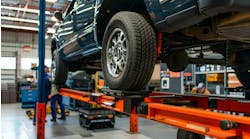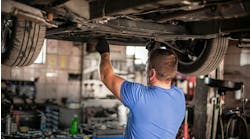I’ve been in the vehicle lift industry for more than 20 years and have seen first-hand how industry standards and manufacturing processes have changed over time. One thing that hasn’t changed, however, is the importance of lift safety.
When my fellow Automotive Lift Institute (ALI) Certified Lift Inspectors and I are out inspecting vehicle lifts, we are seeing lift owners and operators being more proactive when it comes to improving service bay safety. They are recognizing how a strong safety program can help protect their people, equipment, and sustainability of their businesses.
Lift inspections
Lift inspections can help keep technicians safe and may identify minor issues before they grow into more dangerous ones. Inspections can also help shops reduce potential downtime or the cost of lift replacement. ANSI/ALI ALOIM, the national safety standard covering lift operation, inspection, and maintenance, mandates that all vehicle lifts be inspected at least annually by a qualified lift inspector. Hiring an ALI Certified Lift Inspector ensures that you’re working with someone who has been third-party tested and found capable of inspecting any lift. We look at everything, including all electrical and mechanical lift components, training records, and lift maintenance logs.
The outside perspective ALI Certified Lift Inspectors bring is valuable. When technicians use lifts every day and are focused on getting work done, it’s easy for them to unintentionally overlook small things that might cause safety issues. Often, we will show operators or managers issues found during inspection and they are amazed that they’ve overlooked it all day, every day, for months.
Tips for lift operators
Our team encourages technicians to get to know their lifts by looking, listening, and truly paying attention to the characteristics of how the lift operates. Taking this approach will allow the operator to report changes in the condition of the lift to their supervisor or owner at the first sign of any of these conditions:
- Missing or damaged warning and capacity labels. Capacity labels tell technicians at a glance the lift’s rated load capacity to help prevent overloading. Warning labels and safety materials are specific to each lift and should be kept with the lift at all times.
- Damage or excessive wear of lift hoses, wire rope, chains, electrical wires. A hose failure can cause problems ranging from a loss of efficiency to a catastrophic lift failure, so any abnormalities need to be treated immediately. Look for obvious signs of rubbing, cracking, or pinching on all hoses and piping. Look for wear marks, fraying, or signs of stretching on chains, wire ropes, bearings, and pulleys. These items are most prone to wear at the “bends and the ends,” so look closely anywhere they bend around corners or pulleys or where they make a connection.
- Damage or excessive wear of any lift contact points. Any time that there is damage to a lift contact point, you are losing potential “grip” on the vehicle contact point, dramatically increasing the risk of a vehicle shifting or sliding. Check lift contact points such as lifting pads to make sure they are free of debris, grease, oil, and anything else that may prevent solid contact. Make sure that bolt-on rubber pads are secure, and that the rubber or serrated steel isn’t torn or worn.
- Evidence of hydraulic or pneumatic leaks. Hydraulic or pneumatic leaks need to be dealt with as a serious issue. Small leaks can turn into big leaks, which can cause catastrophic failure. Listen for any “hissing” sounds from a pneumatic system, as this could be an early indicator of pneumatic leaks. Look for any evidence of oil outside of a cylinder or on the floor, as this confirms a hydraulic leak is present and must be repaired.
- Cracks or loose concrete around the floor anchor bolts. An old adage in the lift industry is that “a lift is only as strong as the floor it is bolted to.” Any time a crack or other abnormality is found involving the concrete, an assessment needs to be made regarding how the lift and service bay safety may be negatively impacted. If it is determined that either the manufacturer’s instructions or other observations demonstrate a safety concern, appropriate action should be taken immediately. Since some lift types put more stress on the floor than others, any change in the floor (cracks, loose concrete, anchors loosening up) should be investigated.
- It’s important for lift operators to properly use controls, restraints, or load holding (locking) devices to avoid dangerous situations. Load holding devices are at the heart of lift safety – if they are not working or being used properly, it causes the entire load to rest on the hydraulics, wire ropes, or chains. It is imperative that the main controls (lifting and lowering) return to neutral when operators release the controls. If a lift continues raising after the lifting control is released or continues moving downward after the lowering control is released, the lift should not be used until inspected by a qualified lift inspector and serviced before further use. Do not override these controls.
Lift training
A comprehensive lift training program is critical to exceptional service bay safety. Lift operator training should be part of the onboarding process for every new technician and should continue annually, at minimum.
A service bay safety program goes beyond the sign hanging on the wall that says “200 days without an accident.” It means properly and continually training technicians on lifts and all equipment. It’s talking about safety daily and making sure the operators know what to watch for and how to address potential issues.
ALI’s “Lifting It Right” online lift safety training certificate course is a great resource on the proper use of all types of vehicle lifts. New this year, shops can sign up for an annual subscription that gives them unlimited access to the course, so it’s easy to make sure every technician – experienced and new – is trained.
In addition to general lift training, lift operators should be trained on the specific lifts they will be using. Don’t assume that because a technician has 20 years of experience, he or she knows how every type of lift operates. Many ALI Certified Lift Inspectors and lift manufacturer representatives can provide individualized training. To find a local ALI Certified Lift Inspector, visit autolift.org/find-a-certified-auto-lift-inspector/.
Training should cover lift operation and the lift manufacturer’s recommended list of safety checklists, which are designed to help operators spot minor issues before they compromise safety. ALI Certified Lift Inspectors recommend that training involve adoption and execution of a planned lift maintenance program.
Investing in and enforcing a lift safety program pays dividends for shops beyond keeping everyone safe. It improves overall service bay safety, increases the bottom line by reducing workers’ comp claims, limits lift downtime, lowers insurance costs, and minimizes repair costs.
Buck Gasner is operations manager for DEKRA Automotive North America and serves as the associate class representative to the Automotive Lift Institute (ALI) Board of Directors.




